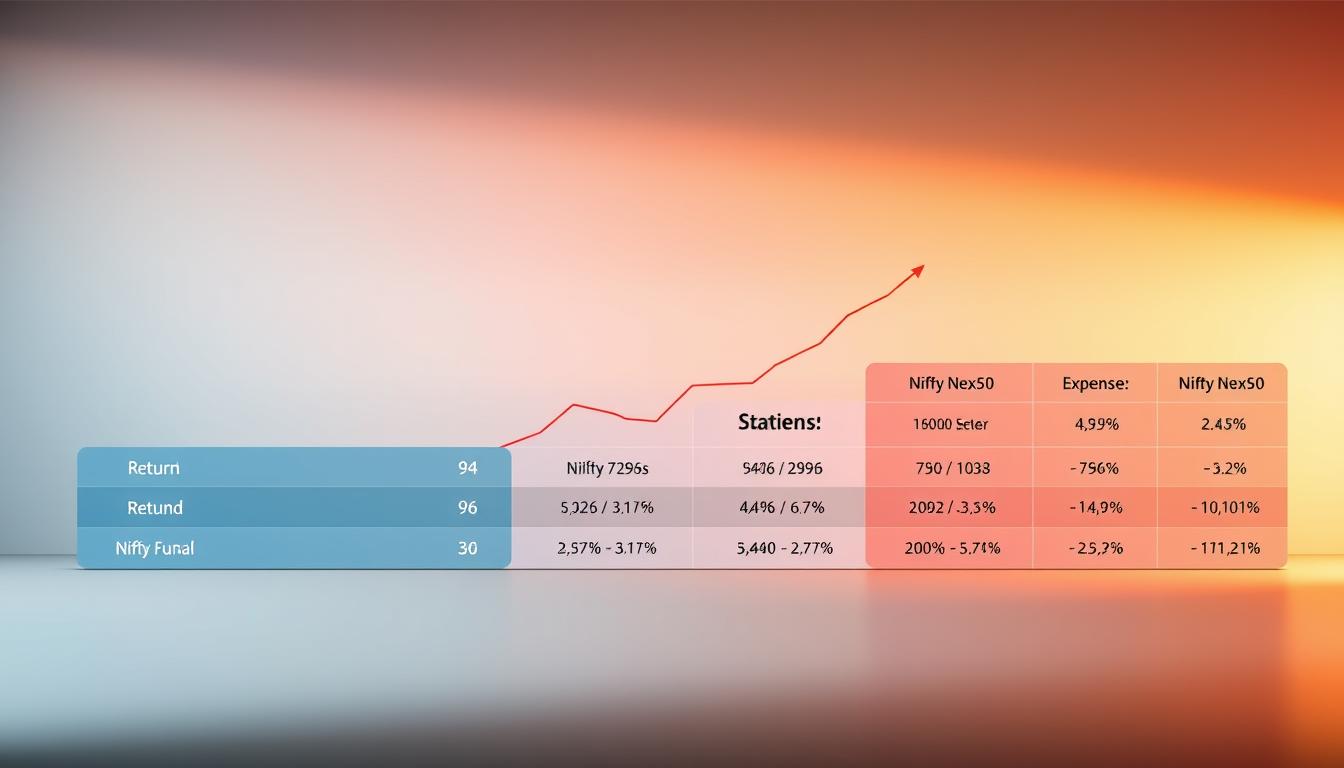Best Index Funds in India for SIP in 2025: Simple, Smart & Steady
Investing in index funds is a favorite among many Indians. It’s a smart way to grow your wealth over time. Systematic Investment Plans (SIPs) make it easy to start investing with a simple, smart, and steady approach.
Index funds are a low-cost way to spread out your investments. They track a market index like the Nifty 50 or Sensex. This way, you can enjoy the market’s overall performance without picking stocks yourself.
Looking ahead to 2025, SIPs in index funds are set to grow even more. This makes them a great choice for both new and experienced investors.
Key Takeaways
- Index funds offer a simple way to invest in the market.
- SIPs allow for regular investments with minimal amounts.
- Diversification is key to a steady investment portfolio.
- Low costs make index funds an attractive investment option.
- 2025 is expected to see continued growth in SIP investments.
Understanding Index Funds and Their Growing Popularity in India
Index funds are becoming more popular in India. They are simple and cost-effective. More investors are choosing them for their benefits in passive investing.
What Are Index Funds and How Do They Work?
Index funds track the performance of a stock market index, like the Nifty 50 or Sensex. They hold the same stocks as the index, in the same amounts. This way, they mirror the index’s performance. It means no need for picking stocks or timing the market, saving investors money.
The Rise of Passive Investing in the Indian Market
The Indian market is moving towards passive investing. Low-cost index funds are leading this trend. They offer a cheap way to invest in the market. So, top index funds are getting more popular among those wanting to grow their wealth over time.
Why SIP in Index Funds Makes Perfect Sense in2025
SIPs in index funds are becoming more popular in 2025. They are simple and effective. Systematic Investment Plans (SIPs) let investors put in a set amount regularly. This helps lessen the effects of market ups and downs and timing risks.
Benefits of Systematic Investment Plans (SIPs)
SIPs have many advantages. They promote disciplined investing, rupee-cost averaging, and the power of compounding. By investing a fixed amount at set times, investors can lower their average cost per unit. This also helps reduce the risks of investing all at once.
Combining SIP with Index Funds: The Power Duo
Pairing SIPs with index funds makes for a strong investment plan. Index funds give broad market exposure and diversification. SIPs ensure steady investment, making it a top choice for building wealth over time.
This mix is especially good in 2025. It offers a simple, smart, and steady way to invest. By using SIPs and index funds, investors can reach their financial goals easily and get good returns.
Key Advantages of Choosing Index Funds for Your SIP
Index funds are a great choice for SIP investors. They offer a low-cost, diversified investment option. By using a Systematic Investment Plan, investors can enjoy several benefits that make investing easier and more efficient.
Low Expense Ratios: More Returns in Your Pocket
Index funds have low expense ratios. They don’t need a team of fund managers to pick stocks. This means lower costs for investors.
Warren Buffett once said, “Price is what you pay. Value is what you get.” With index funds, you keep more of your returns because of these lower costs.
Reduced Manager Risk and Simplified Decision Making
Index funds reduce the risk of relying on a single fund manager. They track a specific index, so the investment strategy is clear. This simplifies decision-making for investors.
Investors can focus on their overall goals. They don’t have to worry about the fund manager’s performance.
Built-in Diversification Benefits
Index funds offer diversification by tracking a broad market index. This includes the Nifty 50 or Sensex. It spreads risk across various stocks and sectors.
Investors get a diversified portfolio without needing to invest in multiple funds. This reduces the overall risk of their investment.
Best Index Funds in India for SIP in2025: Simple, Smart & Steady Options
As we near 2025, more investors are eyeing the best index funds in India for SIPs. The Indian economy looks promising, making it key to find funds for stable long-term returns.
Selection Criteria for Our Top Picks
We picked the top index funds for SIPs in 2025 based on several factors. We looked at their past performance, expense ratio, tracking error, and the fund manager’s experience. Low expense ratios and minimal tracking error were key in our choices.
Understanding Tracking Error and Its Importance
Tracking error shows how well an index fund tracks its index. A lower tracking error means the fund closely mirrors its benchmark. We checked the tracking error of various funds to find those that closely follow their indices.
Index Fund | Tracking Error | Expense Ratio |
UTI Nifty Index Fund | 0.05% | 0.20% |
HDFC Index Fund - Nifty 50 Plan | 0.03% | 0.15% |
SBI Nifty Index Fund | 0.04% | 0.25% |
2025 Market Outlook and Fund Selection Strategy
For 2025, we expect a volatile market due to global economic factors. Our strategy is to choose index funds that have done well in such times. Diversified index funds with a solid track record are likely to stand strong in uncertain markets.
Top Nifty50 Index Funds for SIP Investors
Nifty50 index funds are a great choice for those new to SIP investments. They aim to match the Nifty50 index’s performance. This gives investors a broad market view. Let’s look at some top Nifty50 index funds for SIP investors.
UTI Nifty Index Fund
The UTI Nifty Index Fund is a favorite among investors. It’s known for its low costs and steady performance.
Expense Ratio and Fund Size
It has a 0.05% expense ratio, which is very affordable. With over ₹10,000 crores in assets, it’s also liquid.
Historical Performance and Tracking Error
The fund has tracked the Nifty50 index well, with a 0.07% tracking error. This shows it closely mirrors the index’s performance.
SIP Performance Projection for 2025
For 2025, the fund is expected to return 8-10% with consistent SIP investments. This forecast is based on past data and market trends.
HDFC Index Fund – Nifty50 Plan
The HDFC Index Fund – Nifty50 Plan is also highly regarded. It’s known for its reliability and low costs.
Expense Ratio and Fund Size
It has a 0.07% expense ratio and a ₹5,000 crore fund size. This makes it a good choice for SIP investors.
Historical Performance and Tracking Error
The fund has a 0.09% tracking error. This shows it effectively replicates the Nifty50 index.
SIP Performance Projection for 2025
For 2025, the fund is expected to return 8-10% with SIP investments. This forecast is based on past performance and market analysis.
SBI Nifty Index Fund
The SBI Nifty Index Fund is a solid SIP investment option. It has a low expense ratio and strong historical performance.
Expense Ratio and Fund Size
It has a 0.06% expense ratio and a ₹3,000 crore fund size. It’s an attractive option for investors.
Historical Performance and Tracking Error
The fund has a 0.08% tracking error. This shows it closely follows the Nifty50 index.
SIP Performance Projection for 2025
The fund is expected to return 8-10% with SIP investments in 2025. This forecast is based on historical trends.
Fund Name | Expense Ratio | Fund Size (₹ crores) | Tracking Error |
UTI Nifty Index Fund | 0.05% | 10,000+ | 0.07% |
HDFC Index Fund - Nifty50 Plan | 0.07% | 5,000 | 0.09% |
SBI Nifty Index Fund | 0.06% | 3,000 | 0.08% |
Also Read :- Safe Investment Options in India with Monthly Returns
Best Nifty Next50 Index Funds for Growth-Oriented Investors
Nifty Next50 index funds are great for those who want to grow their investments. They track the Nifty Next50 Index. This index includes the next 50 companies after the Nifty 50. It offers a mix of promising stocks.
ICICI Prudential Nifty Next50 Index Fund
The ICICI Prudential Nifty Next50 Index Fund is a top pick for investors. It has a strong track record and is well-managed.
Expense Ratio and Fund Size
The fund’s expense ratio is 0.05%, which is competitive. Its large size ensures investors can easily buy and sell shares.
Historical Performance and Tracking Error
The fund has closely followed the Nifty Next50 Index over time. Its small tracking error is key for investors who rely on its performance.
SIP Performance Projection for 2025
Investing in the ICICI Prudential Nifty Next50 Index Fund through SIPs could yield big returns in 2025. It’s a good choice for those looking to invest for the long term.
Nippon India Nifty Next50 Index Fund
Nippon India Nifty Next50 Index Fund is another great choice for investors. It aims to capture the growth potential of the Nifty Next50 Index.
Expense Ratio and Fund Size
The fund’s expense ratio is 0.07%, a bit higher than some others. But its size and reputation make up for this.
Historical Performance and Tracking Error
The fund has shown it can mirror the index well. Its low tracking error makes it a reliable option.
SIP Performance Projection for 2025
Investing in this fund through SIPs could lead to attractive returns in 2025. This is thanks to the index’s potential for growth.
Motilal Oswal Nifty Next50 Index Fund
The Motilal Oswal Nifty Next50 Index Fund is a cost-effective way to invest in the Nifty Next50 Index.
Expense Ratio and Fund Size
With an expense ratio of 0.03%, it’s one of the cheapest options. Its moderate size supports efficient operations.
Historical Performance and Tracking Error
The fund has a history of closely following the Nifty Next50 Index. Its minimal tracking error boosts its credibility.
SIP Performance Projection for 2025
SIP investments in this fund are expected to do well in 2025. This is thanks to the growth prospects of the companies it tracks.
Fund Name | Expense Ratio | Fund Size (Crores) | Tracking Error |
ICICI Prudential Nifty Next50 Index Fund | 0.05% | 1200 | 0.10% |
Nippon India Nifty Next50 Index Fund | 0.07% | 1500 | 0.12% |
Motilal Oswal Nifty Next50 Index Fund | 0.03% | 800 | 0.08% |
Promising Sectoral Index Funds for Targeted Exposure
The Indian economy is growing fast. Sectoral index funds are a smart way to invest in key industries. They let investors take advantage of growth in specific sectors.
Aditya Birla Sun Life Nifty Bank ETF
The Aditya Birla Sun Life Nifty Bank ETF is great for those interested in the banking sector. It follows the Nifty Bank Index, giving you a look at top Indian banks.
Banking Sector Outlook for 2025
The banking sector is set to grow in 2025. This growth will come from more lending and going digital.
SIP Strategy for Sectoral Exposure
Using a Systematic Investment Plan (SIP) can lower risks. It also helps you make the most of market ups and downs.
ICICI Prudential IT ETF
The ICICI Prudential IT ETF tracks the Nifty IT Index. It gives you a chance to invest in India’s top IT companies. It’s perfect for those who think the IT sector will do well.
IT Sector Outlook for 2025
The IT sector is expected to grow in 2025. This growth will come from more demand for digital services and tech solutions.
SIP Strategy for Sectoral Exposure
Investing through SIP in sectoral funds can help you. It lets you average out costs and lessen timing risks.
Nippon India Pharma Fund
The Nippon India Pharma Fund is for those who want to invest in pharmaceuticals. It offers a mix of exposure to pharmaceutical companies.
Healthcare Sector Outlook for 2025
The healthcare sector, including pharmaceuticals, is expected to grow a lot in 2025. This growth will come from more healthcare needs and new ideas.
SIP Strategy for Sectoral Exposure
SIP investments in funds like the Nippon India Pharma Fund can help you through market ups and downs.
Fund Name | Sector | 1-Year Return |
Aditya Birla Sun Life Nifty Bank ETF | Banking | 15% |
ICICI Prudential IT ETF | IT | 20% |
Nippon India Pharma Fund | Pharmaceuticals | 12% |
International Exposure: Global Index Funds Available to Indian Investors
Indian investors looking to diversify their portfolios find global index funds appealing. These funds open doors to global markets. They offer the chance to benefit from growth in different economies and sectors.
Motilal Oswal NASDAQ100 Fund of Fund
The Motilal Oswal NASDAQ100 Fund of Fund is a top pick for those interested in the US tech sector. It tracks the NASDAQ-100 index. This gives investors access to the top 100 non-financial companies listed on the NASDAQ.
US Market Outlook for 2025
Experts foresee the US market growing in 2025. This growth is expected to come from tech advancements and innovation. The NASDAQ-100 index is likely to benefit from this trend.
Currency Risk and Hedging Strategies
Investing in international funds carries currency risk. But, some funds use hedging strategies to reduce this risk. It’s important for investors to look at these strategies when choosing a global index fund.
Franklin India Feeder – Franklin U.S. Opportunities Fund
The Franklin India Feeder – Franklin U.S. Opportunities Fund lets Indian investors invest in the Franklin U.S. Opportunities Fund. This fund focuses on growth opportunities in the US.
Fund Performance and Strategy
The fund has a good track record, thanks to its focus on companies with strong growth potential. Investors should check the fund’s performance and strategy to see if it matches their goals.
SIP Allocation Recommendations
For those using a Systematic Investment Plan (SIP), allocating some of their SIP to this fund can offer US market exposure. It’s wise to talk to a financial advisor to find the best SIP allocation.
Edelweiss Greater China Equity Off-shore Fund
The Edelweiss Greater China Equity Off-shore Fund gives investors a chance to invest in the Greater China region. This includes China, Hong Kong, and Taiwan.
Asian Markets Outlook for 2025
Experts believe Asian markets will keep growing in 2025. This growth is expected to come from economic reforms and tech advancements. This fund is a way to benefit from this growth.
Risk-Reward Profile for Indian Investors
While the fund has the potential for high returns, it also carries risks. These risks are linked to emerging markets. Indian investors should carefully consider the risk-reward profile and their risk tolerance before investing.
Smart SIP Strategies for Index Fund Investments
To get the most from SIPs in index funds, you need a solid plan. It’s key to use smart SIP strategies. These help you deal with market ups and downs and reach your financial goals.
Using a mix of strategies is a smart move. It depends on what you want to achieve and how much risk you can take. Here are some top strategies to think about:
Step-Up SIP: Increasing Your Investment Over Time
A Step-Up SIP lets you boost your SIP amount as your income grows. This way, you can invest more as you earn more. For example, you could increase your investment by 10% each year, matching your salary increases.
Core-Satellite Approach with Multiple Index Funds
The Core-Satellite approach puts a big chunk of your money in a core index fund. Then, you invest smaller amounts in satellite funds that focus on different areas. This mix can help you grow your money in various markets while keeping risks low.
Value Averaging Strategy for Market Volatility
A Value Averaging strategy means investing more when prices are low and less when they’re high. This keeps your average investment steady. It’s a smart way to handle market swings and protect your portfolio.
By adding these smart SIP strategies to your index fund investments, you can build a strong plan. It’s made just for you, based on your financial goals and how much risk you’re willing to take.
Tax Efficiency of Index Funds for Long-Term SIP Investors
Understanding the tax efficiency of index funds is key for long-term SIP investors. Index funds, especially those that track equity indices, are tax-efficient. This is because of their nature and the tax rules that apply to them.
LTCG Tax Implications for Equity Index Funds
Long-Term Capital Gains (LTCG) tax applies to equity index funds held over a year. The tax rate is 10% on gains over ₹1 lakh. Investors should know that inflation indexation can lower tax liability.
Tax Harvesting Strategies with Index Funds
Tax harvesting involves selling losing stocks to offset gains. This reduces tax. Index funds are great for this because of their diversification and liquidity. Switching between index funds helps keep market exposure while improving tax position.
Tax Benefits Under Section 80C with ELSS Index Funds
Equity Linked Savings Schemes (ELSS) are index funds that get tax deductions under Section 80C. Investing in ELSS index funds can grow your money long-term and lower taxable income. The three-year lock-in period fits well with long-term SIP plans.
How to Start Your Index Fund SIP Journey: A Step-by-Step Guide
To start investing in index funds through SIP, just follow these easy steps. Investing in index funds via SIPs is a great way to grow your wealth over time.
Choosing the Right Platform: Direct vs. Regular Plans
When picking a platform for your index fund SIP, you have two options. Direct plans let you invest directly with the fund house, saving on costs. Regular plans involve a distributor or broker, offering guidance and support.
Features | Direct Plans | Regular Plans |
Expense Ratio | Lower | Higher due to distribution costs |
Investment Channel | Directly with fund house | Through distributor/broker |
Guidance | Self-directed | Supported by distributor |
KYC and Documentation Requirements
Before investing, you must complete the Know Your Customer (KYC) process. You’ll need to provide identification and address proofs. Having all your documents ready will make the process smoother.
Setting Up Automatic SIP Payments and Monitoring
After completing KYC, set up automatic SIP payments. This way, you invest a fixed amount regularly, without manual effort. It’s also important to check your SIP investments often to keep them on track with your financial goals.
Conclusion: Building Wealth Steadily with Index Fund SIPs
Investing in index fund SIPs is a smart way to grow your wealth over time. It uses the power of compounding and rupee-cost averaging. This helps investors build a big amount of money.
Index funds are great for long-term investing because they have low costs and diversify your investments. By picking the right funds and sticking to a SIP plan, you can get steady returns. This helps you build wealth.
Success in long-term investing comes from being consistent, patient, and having a good plan. Adding index fund SIPs to your portfolio helps you handle market ups and downs. It keeps you on track to meet your financial goals.
With the right approach and knowledge of index fund investing, growing your wealth steadily is possible. Begin your index fund SIP journey today. It’s the first step to a secure financial future.
FAQ
Q.1 What are the best index funds in India for SIP investments in 2025?
For SIP investments in 2025, top picks include UTI Nifty Index Fund and HDFC Index Fund – Nifty50 Plan. SBI Nifty Index Fund is also a great choice. For Nifty Next50, ICICI Prudential Nifty Next50 Index Fund and Nippon India Nifty Next50 Index Fund are recommended.
Q.2 What is the benefit of investing in index funds through SIP?
SIP investments in index funds offer many benefits. They help with rupee cost averaging and reduce timing risks. They also use the power of compounding, making it a smart and steady strategy.
Q.3 How do I choose the right index fund for my SIP investment?
When picking an index fund for SIP, look at the fund’s tracking error and expense ratio. Also, consider the fund size and its historical performance. Your personal goals and risk tolerance are also important.
Q.4 What is tracking error, and why is it important in index funds?
Tracking error shows how much an index fund deviates from its benchmark. A lower error means the fund closely tracks its index. This makes it a more effective choice.
Q.5 Can I invest in international index funds through SIP?
Yes, you can invest in international index funds through SIP. Options like Motilal Oswal NASDAQ100 Fund of Fund and Franklin India Feeder – Franklin U.S. Opportunities Fund are available. Edelweiss Greater China Equity Off-shore Fund is also an option for Indian investors.
Q.6 What are the tax implications of investing in index funds through SIP?
LTCG from equity index funds is taxed at 10% without indexation and 20% with indexation. Debt index funds are taxed at 20% with indexation. Tax harvesting strategies can help optimize tax efficiency.
Q.7 How do I start investing in index fund SIPs?
To start, choose the right platform and complete KYC requirements. Set up automatic SIP payments. Monitor your investments to ensure they align with your goals.
Q.8 What are some smart SIP strategies for index fund investments?
Smart strategies include step-up SIPs and the core-satellite approach. Using multiple index funds can help manage market volatility and optimize returns.
Q.9 Are sectoral index funds a good option for SIP investments?
Sectoral index funds are good for targeted sector exposure, like banking or IT. But, be aware of the risks and consider your overall strategy.
Q.10 What are the benefits of low-cost index funds for SIP investments?
Low-cost index funds have lower expense ratios. This can lead to higher net returns over time, making them a smart choice for SIP investments.
If you found this guide helpful, feel free to share it with a friend who’s planning to start their SIP journey too. And hey, drop a like or comment if you want more such simple investing tips!






One Comment